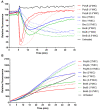BrevicidineB, a New Member of the Brevicidine Family, Displays an Extended Target Specificity
- PMID: 34177875
- PMCID: PMC8219939
- DOI: 10.3389/fmicb.2021.693117
BrevicidineB, a New Member of the Brevicidine Family, Displays an Extended Target Specificity
Abstract
The group of bacterial non-ribosomally produced peptides (NRPs) has formed a rich source for drug development. Brevicidine, a bacterial non-ribosomally produced cyclic lipo-dodecapeptide, displays selective antimicrobial activity against Gram-negative pathogens. Here, we show that brevicidineB, which contains a single substitution (Tyr2 to Phe2) in the amino acid sequence of the linear part of brevicidine, has a broadened antimicrobial spectrum, showing bactericidal activity against both Gram-negative (with a MIC value of 2 to 4 mg/L) and Gram-positive (with a MIC value of 2 to 8 mg/L) pathogens. Compared with an earlier reported member of the brevicidine family, the broadened antimicrobial spectrum of brevicidineB is caused by its increased membrane disruptive capacity on Gram-positive pathogens, which was evidenced by fluorescence microscopy assays. In addition, DiSC3(5) and resazurin assays show that brevicidine and brevicidineB exert their antimicrobial activity against Gram-negative bacteria via disrupting the proton motive force of cells. Notably, as a brevicidine family member, brevicidineB also showed neither hemolytic activity nor cytotoxicity at a high concentration of 64 mg/L. This study provides a promising antibiotic candidate (brevicidineB) with a broad antimicrobial spectrum, and provides novel insights into the antimicrobial mode of action of brevicidines.
Keywords: Brevicidine; NRPs; antimicrobial activity; cyclic peptide; lipopeptide.
Copyright © 2021 Zhao and Kuipers.
Conflict of interest statement
The authors declare that the research was conducted in the absence of any commercial or financial relationships that could be construed as a potential conflict of interest.
Figures





Similar articles
-
Elucidating the Mechanism of Action of the Gram-Negative-Pathogen-Selective Cyclic Antimicrobial Lipopeptide Brevicidine.Antimicrob Agents Chemother. 2023 May 17;67(5):e0001023. doi: 10.1128/aac.00010-23. Epub 2023 Mar 13. Antimicrob Agents Chemother. 2023. PMID: 36912655 Free PMC article.
-
Synthesis, Structure-Activity Relationship Study, Bioactivity, and Nephrotoxicity Evaluation of the Proposed Structure of the Cyclic Lipodepsipeptide Brevicidine B.J Nat Prod. 2024 Apr 26;87(4):764-773. doi: 10.1021/acs.jnatprod.3c00876. Epub 2024 Feb 29. J Nat Prod. 2024. PMID: 38423998
-
Mimicry of a Non-ribosomally Produced Antimicrobial, Brevicidine, by Ribosomal Synthesis and Post-translational Modification.Cell Chem Biol. 2020 Oct 15;27(10):1262-1271.e4. doi: 10.1016/j.chembiol.2020.07.005. Epub 2020 Jul 23. Cell Chem Biol. 2020. PMID: 32707039
-
Overview of ribosomal and non-ribosomal antimicrobial peptides produced by Gram positive bacteria.Cell Mol Biol (Noisy-le-grand). 2017 Oct 31;63(10):20-32. doi: 10.14715/cmb/2017.63.10.4. Cell Mol Biol (Noisy-le-grand). 2017. PMID: 29096754 Review.
-
Mode of action of the new antibiotic for Gram-positive pathogens daptomycin: comparison with cationic antimicrobial peptides and lipopeptides.Biochim Biophys Acta. 2006 Sep;1758(9):1215-23. doi: 10.1016/j.bbamem.2006.02.009. Epub 2006 Mar 3. Biochim Biophys Acta. 2006. PMID: 16615993 Review.
Cited by
-
Discovery of Paenibacillaceae Family Gram-Negative-Active Cationic Lipopeptide Antibiotics Using Evolution-Guided Chemical Synthesis.Org Lett. 2022 Jul 15;24(27):4943-4948. doi: 10.1021/acs.orglett.2c01879. Epub 2022 Jul 1. Org Lett. 2022. PMID: 35776528 Free PMC article.
-
Brevibacillin 2V, a Novel Antimicrobial Lipopeptide With an Exceptionally Low Hemolytic Activity.Front Microbiol. 2021 Jun 17;12:693725. doi: 10.3389/fmicb.2021.693725. eCollection 2021. Front Microbiol. 2021. PMID: 34220785 Free PMC article.
-
Synthetic indole derivatives as an antibacterial agent inhibiting respiratory metabolism of multidrug-resistant gram-positive bacteria.Commun Biol. 2024 Nov 12;7(1):1489. doi: 10.1038/s42003-024-06996-8. Commun Biol. 2024. PMID: 39533040 Free PMC article.
-
An accurate strategy for pointing the key biocatalytic sites of bre2691A protein for modification of the brevilaterin from Brevibacillus laterosporus.Microb Cell Fact. 2022 Sep 19;21(1):196. doi: 10.1186/s12934-022-01918-x. Microb Cell Fact. 2022. PMID: 36123650 Free PMC article.
-
Comparative Genomics Insights into a Novel Biocontrol Agent Paenibacillus peoriae Strain ZF390 against Bacterial Soft Rot.Biology (Basel). 2022 Aug 4;11(8):1172. doi: 10.3390/biology11081172. Biology (Basel). 2022. PMID: 36009799 Free PMC article.
References
-
- Al-Ayed K., Ballantine R. D., Zhong Z., Li Y., Cochrane S., Martin N. (2021). Total Synthesis of the Brevicidine and Laterocidine Family of Lipopeptide Antibiotics. bioRvix [Preprint] 10.26434/chemrxiv.13660949 - DOI
LinkOut - more resources
Full Text Sources
Other Literature Sources
Molecular Biology Databases

